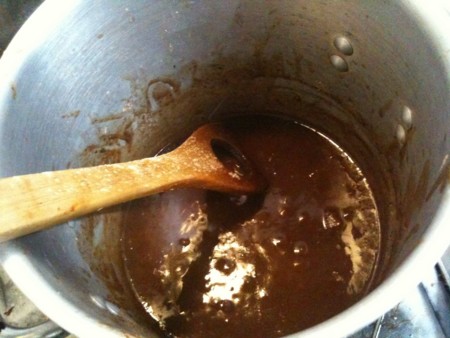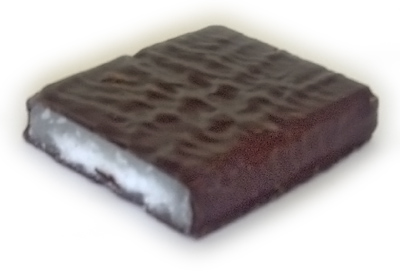|
Glaze (cooking Technique)
In cooking, a glaze is a glossy, translucent coating applied to the outer surface of a dish by dipping, dripping, or using a brush. Depending on its nature and intended effect, a glaze may be applied before or after cooking. It may be either sweet or savory (in pâtisserie, the former is known as ''glaçage''); typical glazes include brushed egg whites, some types of icing, and jam (as in '' nappage''), and may or may not include butter, sugar, milk, oil, and fruit or fruit juice. Examples Doughnut glaze is made from a simple mixture of confectioner's sugar and water, which is then poured over the doughnuts. Some pastries have a coating of egg whites brushed-on. Some pastries use a "mirror glaze", which is glossy enough to create reflections, and some candies and confections are coated in edible wax glazes, often during tumbling. A savory glaze such as demi-glace can be made from reduced stock or meat glaze that is poured onto meat or vegetables. A glazed ham may have its ... [...More Info...] [...Related Items...] OR: [Wikipedia] [Google] [Baidu] |
Candy
Candy, also called sweets (British English) or lollies (Australian English, New Zealand English), is a confection that features sugar as a principal ingredient. The category, called ''sugar confectionery'', encompasses any sweet confection, including chocolate, chewing gum, and sugar candy. Vegetables, fruit, or nuts which have been glazed and coated with sugar are said to be ''candied''. Physically, candy is characterized by the use of a significant amount of sugar or sugar substitutes. Unlike a cake or loaf of bread that would be shared among many people, candies are usually made in smaller pieces. However, the definition of candy also depends upon how people treat the food. Unlike sweet pastries served for a dessert course at the end of a meal, candies are normally eaten casually, often with the fingers, as a snack between meals. Each culture has its own ideas of what constitutes candy rather than dessert. The same food may be a candy in one culture and a dessert ... [...More Info...] [...Related Items...] OR: [Wikipedia] [Google] [Baidu] |
Confectionery
Confectionery is the Art (skill), art of making confections, which are food items that are rich in sugar and carbohydrates. Exact definitions are difficult. In general, however, confectionery is divided into two broad and somewhat overlapping categories: bakers' confections and sugar confections. The occupation of confectioner encompasses the categories of cooking performed by both the French ''Pâtissier, patissier'' (pastry chef) and the ''confiseur'' (sugar worker). Bakers' confectionery, also called flour confections, includes principally sweet pastries, cakes, and similar Baking, baked goods. Baker's confectionery excludes everyday Bread, breads, and thus is a subset of products produced by a baker. Sugar confectionery includes candies (also called ''sweets'', short for ''sweetmeats'', in many English-speaking countries), candied nuts, chocolates, chewing gum, bubble gum, pastillage, and other confections that are made primarily of sugar. In some cases, chocolate conf ... [...More Info...] [...Related Items...] OR: [Wikipedia] [Google] [Baidu] |
Meat Glaze
Meat glaze, French: ''glace de viande'', is a dark brown, gelatinous flavouring agent used in food preparation. It is obtained by reducing brown stock through evaporation by slow heating. Its high viscosity and salt content gives it an unusually long shelf life.Auguste Escoffier (1907), ''Le Guide culinaire''. See also *Demi-glace Demi-glace (, 'half glaze') is a rich brown sauce in French cuisine used by itself or as a base for other sauces. The term comes from the French word ''glace'', which, when used in reference to a sauce, means "icing" or "glaze." It is traditio ... References {{ingredient-stub French cuisine ... [...More Info...] [...Related Items...] OR: [Wikipedia] [Google] [Baidu] |
Demi-glace
Demi-glace (, 'half glaze') is a rich brown sauce in French cuisine used by itself or as a base for other sauces. The term comes from the French word ''glace'', which, when used in reference to a sauce, means "icing" or "glaze." It is traditionally made by combining one part espagnole sauce and one part brown stock. The sauce is then reduced by half, strained of any leftover impurities, and finished with a sherry wine. Common variants of demi-glace use a 1:1 mixture of beef or chicken stock to sauce espagnole; these are referred to as "beef demi-glace" (''demi-glace au bœuf'') or "chicken demi-glace" (''demi-glace au poulet''). The term "demi-glace" by itself implies that it is made with the traditional veal stock. Preparation The basic recipe for demi-glace is provided by the French chef Auguste Escoffier, who is often considered to have refined the method of French cooking, as well as codified many standard French recipes. Although many recipes for demi-glace give the p ... [...More Info...] [...Related Items...] OR: [Wikipedia] [Google] [Baidu] |
Marron Glacé
A marron glacé (plural ''marrons glacés'') is a confection, originating in northern Italy and southern France consisting of a chestnut candied in sugar syrup and glazed. Marrons glacés are an ingredient in many desserts and are also eaten on their own. History Candied chestnuts appeared in chestnut-growing areas in northern Italy and southern France shortly after the crusaders returned to Europe with sugar. Cooking with sugar allowed creation of new confectioneries. A candied chestnut confection was probably served around the beginning of the 15th century in Piedmont, among other places.Vegetarians in Paradise But ''marrons glacés'' as such (with the last touch of 'glazing'), may have been created only in the 16th century. |
Enrobing
An enrober is a machine used in the confectionery industry to coat a food item with a coating medium, typically chocolate. Foods that are coated by enrobers include nuts, ice cream, toffee, chocolate bars, biscuits and cookies. Enrobing with chocolate extends a confection's shelf life. The enrober machine was invented in France in 1903, brought to the United States, and perfected to perform the work of at least twenty people. The process of enrobing involves placing the items on the enrober's feed band, which may consist of a wire mesh or containers in which the confection to be enrobed are placed, with each container having drain holes to recover excess chocolate. The enrober maintains the coating medium at a controlled constant temperature and pumps the medium into a flow pan. The medium flows from the flow pan in a continuous curtain and bottoming bed that the food items pass through, completely coating them. A wire mesh conveyor belt then transports the coated confection to a ... [...More Info...] [...Related Items...] OR: [Wikipedia] [Google] [Baidu] |
Couverture Chocolate
Couverture chocolate is a chocolate that contains a higher percentage of cocoa butter (32–39%) than baking or eating chocolate. This additional cocoa butter, combined with proper tempering, gives the chocolate more sheen, a firmer "snap" when broken, and a creamy mellow flavor. Definition and term The total "percentage" cited on many brands of chocolate is based on some combination of cocoa butter in relation to cocoa solids (cacao). In order to be properly labeled as "couverture", the dark chocolate product must contain not less than 35% total dry cocoa solids, including not less than 31% cocoa butter and not less than 2.5% of dry non-fat cocoa solids, milk chocolate couverture must contain not less than 25% dry cocoa solids. Couverture is used by professionals for dipping, coating, molding and garnishing. The term "couverture chocolate" is distinct from compound chocolate. Products that contain compound chocolate have a lower percentage of solids and contain non-cocoa fat ... [...More Info...] [...Related Items...] OR: [Wikipedia] [Google] [Baidu] |
Pastry Brush
A pastry brush, also known as a basting brush, is a cooking utensil used to spread butter, oil or glaze on food. Traditional pastry brushes are made with natural bristles or a plastic or nylon fiber similar to a paint brush, while modern kitchen brushes may have silicone bristles. In baking breads and pastries, a pastry brush is used to spread a glaze or egg wash on the crust or surface of the food.Julia Child (1996). '' Baking with Julia'' William Morrow and Company Inc. — (USA) In roasting meats, a pastry brush may be used to sop up juices or drippings from under pan and spread them on the surface of the meat to crisp the skin. See also * Basting (cooking) * Pastry chef * Kitchen gadget A kitchen utensil is a small hand held tool used for food preparation. Common kitchen tasks include cutting food items to size, heating food on an open fire or on a stove, baking, grinding, mixing, blending, and measuring; different utensils a ... References {{DEFAULTSORT:Pastry ... [...More Info...] [...Related Items...] OR: [Wikipedia] [Google] [Baidu] |
Glazed Ham
Gammon is the hind leg of pork after it has been cured by dry-salting or brining, which may or may not be smoked. Strictly speaking, a gammon is the bottom end of a whole side of bacon (which ''includes'' the back leg), ham is just the back leg cured on its own. Like bacon, it must be cooked before it can be eaten; in that sense gammon is comparable to fresh pork meat, and different from dry-cured ham like prosciutto.W K H Bode; M J Leto. The Larder Chef'. Routledge; 25 June 2012. . p. 178–. The term is mostly used in the United Kingdom and Ireland, while other dialects of English largely make no distinction between gammon and ham. Ham hock, gammon hock, or knuckle, is the back end of the joint, and contains more connective tissue and sinew.GOOD HOUSEKEEPING. Gh Food Encyclopedia'. Anova Books; 2009. . p. 185–. In the United Kingdom and Ireland, joints of cooked gammon are often served at Christmas. It can be found in most supermarkets either as a full joint or sliced in ... [...More Info...] [...Related Items...] OR: [Wikipedia] [Google] [Baidu] |
Meat Glaze
Meat glaze, French: ''glace de viande'', is a dark brown, gelatinous flavouring agent used in food preparation. It is obtained by reducing brown stock through evaporation by slow heating. Its high viscosity and salt content gives it an unusually long shelf life.Auguste Escoffier (1907), ''Le Guide culinaire''. See also *Demi-glace Demi-glace (, 'half glaze') is a rich brown sauce in French cuisine used by itself or as a base for other sauces. The term comes from the French word ''glace'', which, when used in reference to a sauce, means "icing" or "glaze." It is traditio ... References {{ingredient-stub French cuisine ... [...More Info...] [...Related Items...] OR: [Wikipedia] [Google] [Baidu] |
Stock (food)
Stock, sometimes called bone broth, is a savory cooking liquid that forms the basis of many dishes particularly soups, stews, and sauces. Making stock involves simmering animal bones, meat, seafood, or vegetables in water or wine, often for an extended period. Mirepoix or other aromatics may be added for more flavor. Preparation Traditionally, stock is made by simmering various ingredients in water. A newer approach is to use a pressure cooker. The ingredients may include some or all of the following: Bones: Beef and chicken bones are most commonly used; fish is also common. The flavor of the stock comes from the bone marrow, cartilage and other connective tissue. Connective tissue contains collagen, which is converted into gelatin that thickens the liquid. Stock made from bones needs to be simmered for long periods; pressure cooking methods shorten the time necessary to extract the flavor from the bones. Meat: Cooked meat still attached to bones is also used as an ing ... [...More Info...] [...Related Items...] OR: [Wikipedia] [Google] [Baidu] |
.jpg)




.jpg)
